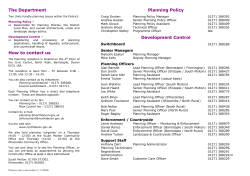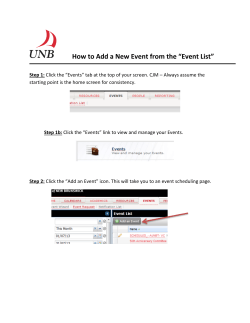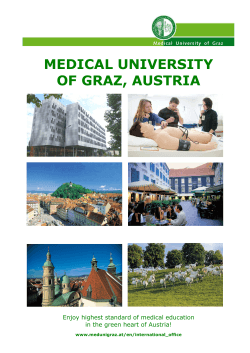
Measurements of Room Acoustic Parameters in Auditoriums Stefan Birnstingl , Maria Fellner
Measurements of Room Acoustic Parameters in Auditoriums by Simulating the Audience by Molton Cloth Stefan Birnstingl2, Maria Fellner1, Franz Graf1 1 Joanneum Research Forschungsgesellschaft mbH, A-8010 Graz, Austria Email: maria.fellner@joanneum.at, franz.graf@joanneum.at 2 Technical University Graz, A-8010 Graz, Austria, Email: stefan.birnstingl@gmx.at Introduction Several measurements of room acoustic parameters have been published in the past, where concert halls with and without audiences have been measured. Hidaka et al. [1] and Lorenz/Breuer [2] additionally have used a special japanese cloth covering the seats for simulating the characteristic absorption of sound by a “real” audience. In this paper results of similar measurements using a cloth named Molton are published. This cloth is often used in theatre and stage design, it is very easy to get and reasonably priced. Room acoustic measurements were made in two auditoriums, a music rehearsal room and a reverberation chamber. Results of the occupied, the unoccupied and the “audience simulated” state were compared. (volume, number of persons during measurements for the occupied state, and reverberation time RT30 at 1 kHz for the unoccupied and the occupied state). Volume (m3) 700 350 1690 183 Persons RT30unocc. (1 kHz) 0.65 1.60 2.80 5.64 Rehearsal room 39 Auditorium 45 Aula 68 Reverberation 16 chamber Table 1: Parameters of the measured rooms RT30occ. (1 kHz) 0.56 0.88 1.66 1.86 Figure 1 to 4 show these rooms unoccipied, with Molton and occupied. Methods As described in [1] and [2] the method used was laying a cloth over the entire seating area. [1] and [2] use a japanese polyester textile (type ka 0149-0172). We use a cotton textile called Molton, which has similar characteristics. The weight of molton is 300 g/m2. It consists of 100 % cotton, has a thickness of about 0.5 mm and is flameretardent. Available widths are 2 and 3 m, available length up to 60 m. As molton is often used for theatre and stage design many colors are available and it is very reasonable priced. For the acoustical measurements according to EN ISO 3382:2000 and EN ISO 354:2003 WinMLS 2000 was used. This software uses a MLS signal for measuring and calculating the room impulse response and several room acoustic parameters. An external sound card (M-Audio FW 410) connected with a notebook, omnidirectional microphones (AKG SE 300B with CK-92) and a dodecahedral loudspeaker (Norsonic 270H with preamplifier) and were used. For further comparison of methods one of the rooms was additionally measured by using the Larson&Davis Analyzer 2900 (excitation signal: pink noise). In each room two different positions for the sound source and several positions for the microphones were used. The number of positions were dependend on the room size. Measurements were done in four different rooms in Austria: the rehearsal room of the Trachtenmusikkapelle in Schäffern, an auditorium (Hörsaal XII) and the Aula of Technical University Graz, and the reverberation chamber of the Allgemeine Unfallversicherungsanstalt (AUVA) in Vienna. Table 1 shows some parameters of these rooms Figure 1: Rehearsal room of the Trachtenmusikkapelle in Schäffern: unoccupied, with Molton and occupied. Figure 2: Auditorium (Hörsaal XII) of the Technical University Graz: unoccupied, with Molton and occupied. Figure 3: Aula of the Technical University Graz: with Molton and occupied. 3 2,5 RT30 (s) 2 1,5 1 0,5 0 40 50 63 80 100 125 160 200 250 315 400 500 630 800 1000 1260 1600 2000 2500 3160 4000 5000 6300 8000 Frequency (Hz) Figure 7: RT30 of the Aula of the Technical University Graz: unoccupied (——), with Molton (- c- -) and occupied (.....). Figure 4: Reverberation chamber of the Allgemeine Unfallversicherungsanstalt (AUVA) in Vienna: unoccupied, with Molton and occupied. 7 6 5 For the first measured room (rehearsal room Schäffern) the MLS method was compared with measurements of the Larson&Davis 2900 real time analyzer. It appeared that the results were almost identically. For the following rooms only the MLS method was used. Figure 5 to 8 show the reverberation time T30 for the unoccupied (—) and the occupied state (......) as well as the measurement with Molton (- - -). For RT30 of all rooms you can see that the measurements with Molton and with the occupied state are very similar, but RT30 of the unoccupied state of these rooms differs considerably. Similar results were obtained for other room acoustic parameters, as you can see in tab. 2. RT30 (s) Results 4 3 2 1 0 40 50 Room State Rehearsal room unoccupied Molton occupied unoccupied Molton occupied unoccupied Molton occupied Aula RT30 (s) Auditorium 0,4 C50/dB (1kHz) 4,0 5,8 4,1 -3,2 -1,0 -1,3 -0,7 2,9 2,2 D50/% (1kHz) 71,5 78,7 71,4 33,6 44,9 43,2 46,0 66,3 62,8 EDT/s (1kHz) 0,69 0,54 0,60 2,74 1,76 1,61 1,55 0,82 0,87 TC/ms (1kHz) 40,1 32,7 39,2 172 105 100 99,2 50,2 53,3 STI 0,70 0,73 0,72 0,47 0,53 0,55 0,56 0,66 0,67 T30/s (1kHz) 0,69 0,55 0,57 2,78 1,77 1,62 1,59 0,84 0,82 Table 2: Room acoustic parameters of the measured rooms unoccupied, with Molton and occupied. 0,2 63 0 80 0 10 00 12 60 16 00 20 00 25 00 31 60 40 00 50 00 63 00 80 00 31 5 50 0 40 0 25 0 20 0 16 0 80 12 5 63 10 0 50 40 0 Frequency (Hz) Conclusion Figure 5: RT30 of the rehearsal room of the Trachtenmusikkapelle in Schäffern: unoccupied (——), with Molton (- c- -) and occupied (.....) 2 1,8 1,6 Measurements in four rooms were made using Molton covering the seats to simulate the audience. It is shown that using this molton textile is a very practical and validate method for simulating the occupied state in a hall without the need of live audience during the measurements. Many thanks to Allgemeine Unfallversicherungsanstalt (AUVA) for letting us use their reverberation chamber. 1,4 1,2 RT30 (s) 100 125 160 200 250 315 400 500 630 800 1000 1260 1600 2000 2500 3160 4000 5000 6300 8000 Figure 8: RT30 of the reverberation chamber of the Allgemeine Unfallversicherungsanstalt (AUVA) in Vienna: unoccupied (——), with Molton (- c- -) and occupied (.....). 0,8 0,6 80 Frequency (Hz) 1,2 1 63 1 0,8 References 0,6 0,4 0,2 00 00 00 60 00 00 00 60 00 80 63 50 40 31 25 20 16 12 0 0 0 0 00 80 63 10 50 40 0 5 31 25 0 5 0 20 16 12 0 10 80 63 50 40 0 Frequency (Hz) Figure 6: RT30 of the auditorium (Hörsaal XII) of the Technical University Graz: unoccupied (——), with Molton (- c- -) and occupied (.....). [1] T. Hidaka, N. Nishihara, L. Beranek: Relation of acoustical parameters with and without audiences in concert halls and a simple method for simualtiung the occupied state. J. Acoust. Soc. Am. 109 (3), March 2001, 1028-1042 [2] K.-H. Lorenz, F. Breuer: Simulation des Publikums durch spezielle Polyester-Textilien bei der raumakustischen Messung von Konzertsälen in der Praxis. DAGA - Fortschritte der Akustik, Aachen, 2003.
© Copyright 2025












